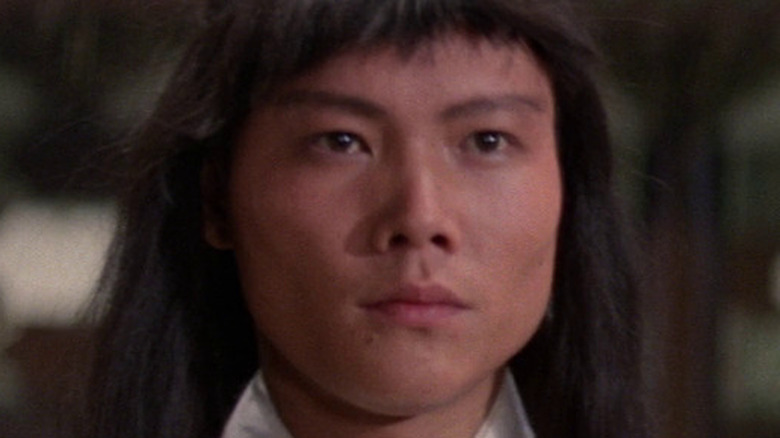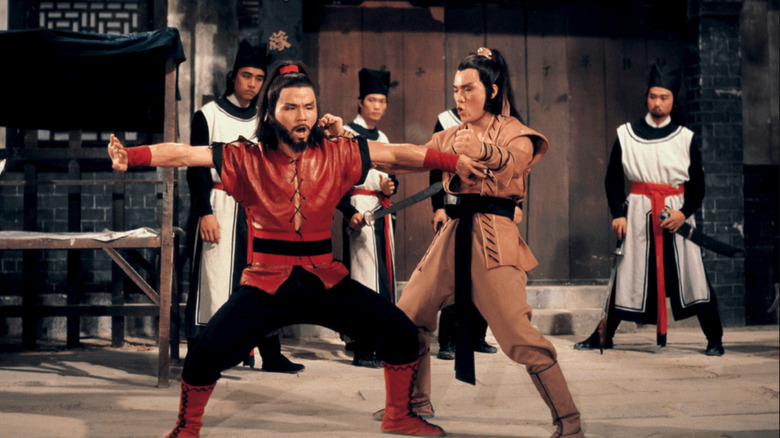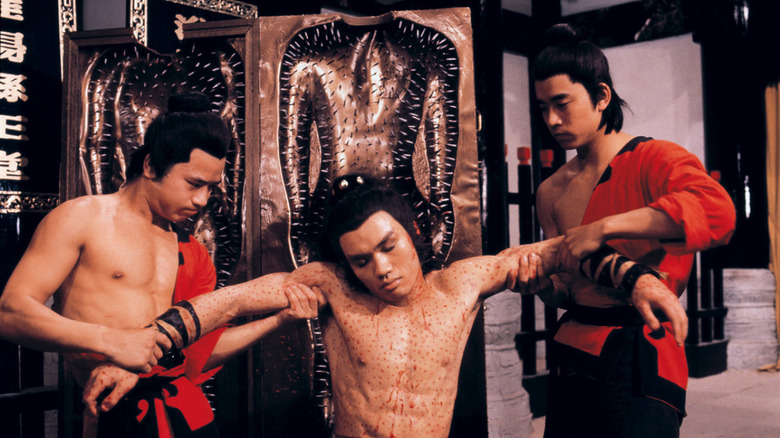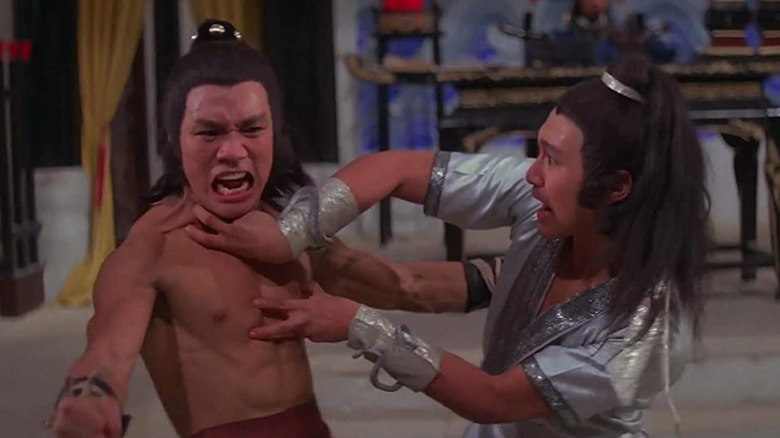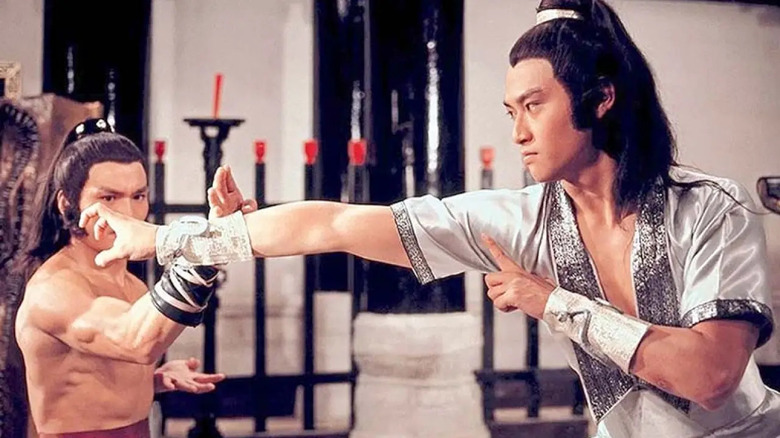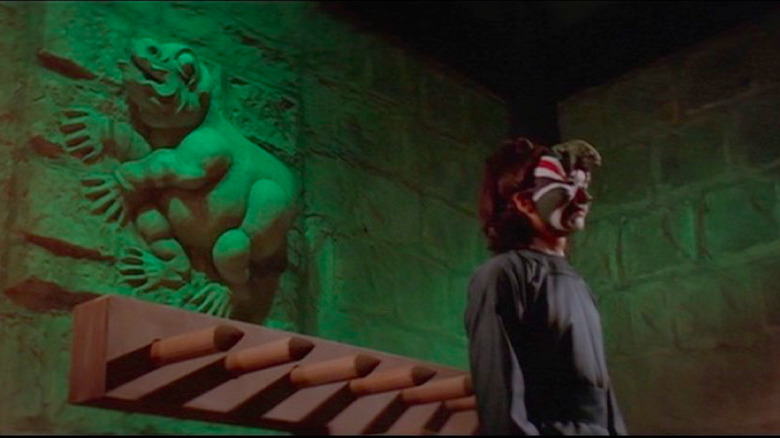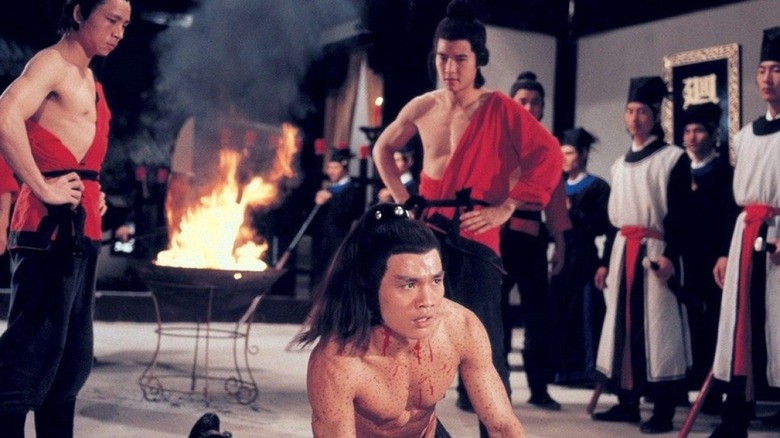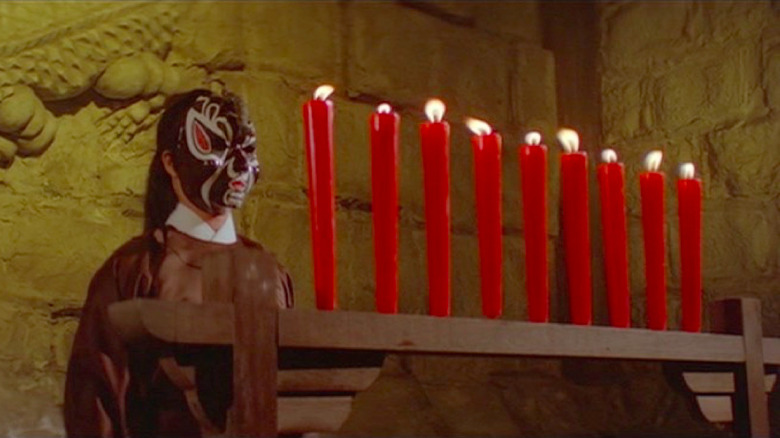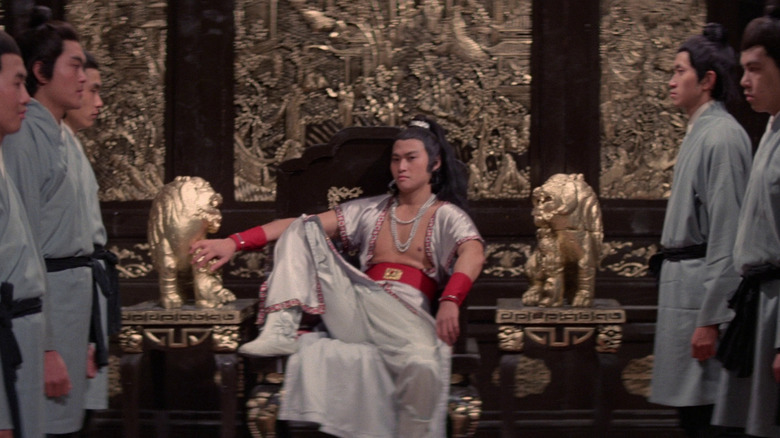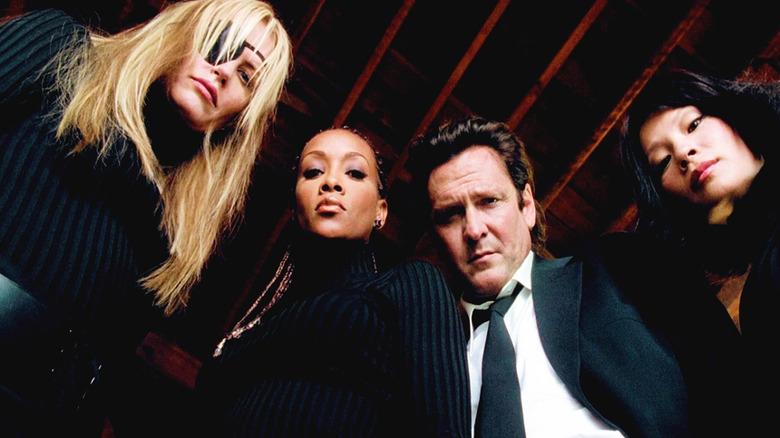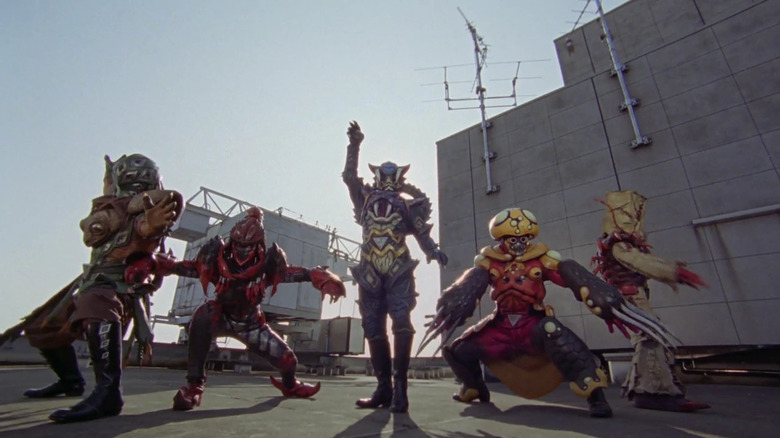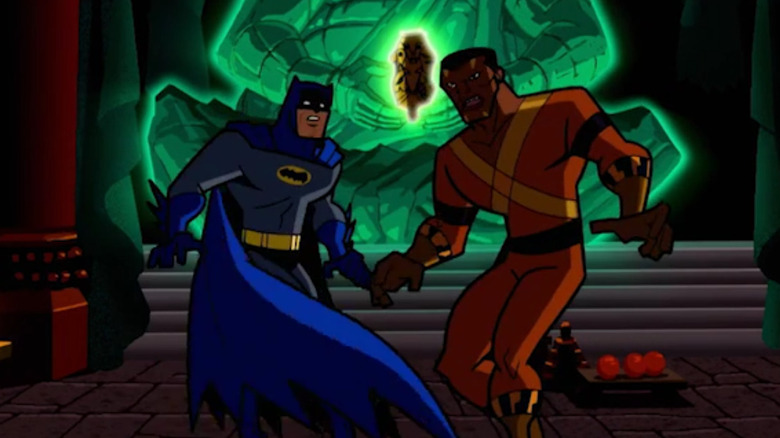Five Deadly Venoms Facts That Fans Will Get A Kick Out Of
There's no shortage of epic martial arts films being made today, but ask most fans of the genre and they'll tell you that the golden era was back in the late 1970s. At that time visionary directors like Cheh Chang had partnered up with incredibly efficient film studios like Shaw Brothers to produce an incredible amount of gory martial arts movies that have stood the test of time. The Kung Fu classic "Five Deadly Venoms" is a result of that exact partnership, and more than 40 years later its action scenes stand head and shoulders above almost anything being produced today. The film follows Yang Tieh, the last student of the House of Venom, who's sent on a quest by the House's master to redeem his legacy. Some of the master's previous students have gone rogue and are using their nearly superhuman martial arts abilities — fighting forms based on the toad, snake, scorpion, lizard, and centipede — for evil aims. Yang Tieh must discover the identities of all the former students and cooperate with any who haven't become corrupted to stop the evildoers.
The film uses that complicated premise to jump-kick into stunning, long-take fight scenes that are guaranteed to leave viewers breathless at every turn. "Five Deadly Venoms" is hardly a martial arts hidden gem — it's had a lasting impact on everything from cartoons to rap groups — but it's definitely a must-watch. Here's a look at the facts behind the fiction of Chang's unforgettable film.
The film has roots in the opera
People don't often talk about opera and martial arts movies in the same breath, but not every movie is like "Five Deadly Venoms." Even casual viewers of the film can tell that its action scenes are the product of a director who pays particular attention to choreography, as well as actors that have the skills to pull off incredible acrobatic feats. The cast of "Five Deadly Venoms" were martial arts actors who don't even have black belts. Instead, they gained their skills from the opera.
In a 2016 interview, Philip Kwok (who played the Lizard Venom in the movie) said that he never actually learned Kung Fu. Instead, he began training in acrobatics before he was even a teenager. His parents were performers in Taiwanese Opera, and he followed in their footsteps as soon as he was able. Years later Kwok joined a different opera troupe and met Chiang Sheng, the man who plays Yang Tieh in the film and who would later become a part of the Venom Mob. According to Den of Geek, director Cheh Chang had an interest in Chinese Opera, which might explain why he gravitated toward actors who were formal opera performers. Chang was able to combine his own movement ideas with the skills of his actors and the help of some wires from time to time to create spectacularly visual fight scenes that are still mind-blowing to watch more than 40 years later.
The Venoms are based on Chinese folklore
"Five Deadly Venoms" tells an original story created by Cheh Chang and Kuang Ni, but the film borrows elements from existing tales. The idea of a student sent on a quest to redeem the flaws of his master is as old as time itself, and the plot's obsession with mistaken identities and criminal intrigue would feel right at home in a Shakespeare play. The film's most iconic feature — the Venoms themselves — are actually modeled on a bit of ancient Chinese folklore that has ties to Daoist philosophy.
In order to ward off bad luck and evil influences, some Daoist practitioners would carry medallions that represented five different poisons (via Primal Trek). The idea was that only poison could fight back against poison, so the medallions were engraved with representations of five different deadly animals. Just like the Venoms in the movie, the poisonous animals on the medallions were snakes, scorpions, toads, centipedes, and lizards, though that last one was sometimes replaced with spiders. When Chang and Ni began writing their tale, they based their core cast on something that most of their viewing audience would immediately recognize. The reference is likely lost on some in the West, but it adds another layer to the already symbol-laden story of "Five Deadly Venoms."
Chiang Sheng and Philip Kwok were street performers
Chiang Sheng and Philip Kwok both received their formal acrobatic training in opera troupes, but the two first met when they had decided to go out on their own to find their paths as performers. Kwok told an interviewer that when he left his first troupe he turned to street performing. It didn't take long for him to run into other opera trainees who were trying to make it on their own, and one of those chance encounters introduced him to Sheng. Kwok and Shen got along well and decided to start working together. "So we created a Fu Xing circus act and performed virtually everywhere," Kwok said. Their performances were primarily focused on showing off their acrobatic skills, and their physical feats were so impressive that audiences didn't mind the lack of storytelling.
According to Kwok, even though he was able to make a decent living as a street performer, the work didn't prepare him very well for his later acting career. He met Cheh Chang, who liked Kwok's acrobatics enough that he decided to include him in his next film, but Kwok said, "When it came time to do scenes with no Kung Fu in them, I always felt my heart beating very fast, and I was extremely nervous saying the lines." He managed to power through, learn new skills, and become a movie star in his own right.
Shaw Brothers Studio resisted the film at first
Cheh Chang began his directorial career in the 1950s. He made his debut in 1958 with "Ye huo" and made over a dozen more films over the following decade. Today he's known as the man behind some of the wildest martial arts films of the '70s and '80s, but even though his reputation as a master of the art form was well-established by the late '70s, Cheh still faced something of an uphill battle when he wanted to make "Five Deadly Venoms."
In an interview with the magazine Eastern Heroes, Philip Kwok opened up about how it was really him and the other Venoms who almost caused the movie to be passed over. "We had been working with Chang Cheh for a number of films but only in supporting roles," he said. Some at Shaw Brothers Studio were hesitant to produce a film that didn't have any well-established stars that could guarantee an audience would come to the theaters. Looking back at how famous the entire main cast became following the release of "Five Deadly Venoms," the studio's resistance to the film seems funny, but there was a real concern that it would lose money. Ultimately, it was Chang's rock-solid reputation that allowed the film to move forward. "People were a bit reluctant at first since no big stars were in the picture but Chang Cheh was a god at Shaw Brothers," Kwok said.
The Venom Mob came to dominate
When "Five Deadly Venoms" was released the film was such a massive hit that it launched extensive careers for its core cast. Philip Kwok, Chiang Sheng, Lu Feng, Lo Meng, and Sun Chien were the actors who'd given Shaw Brothers pause when Cheh Chang had first proposed the film. Then the director proved that his reputation as a star-maker was truly solid. After the film's stunning success, its group of stars became known as the Venom Mob, and they went on to make over 30 films with Chang over the next handful of years (via Den of Geek). The full roster of the Venom Mob didn't always appear together in every film, but in one combination or another the team dominated the Chinese box office and Shaw Brothers Studio into the mid-'80s.
Part of what made the Venom Mob such a success was their ability to fit into archetypes that make for compelling films. Kwok starred in a heroic role in most of the group's pictures, and he was a masterful choreographer. Sheng was the heartthrob of the group, even earning the nickname "Cutie Pie." Feng perfected villainous characters and almost always played an antagonist. Meng built on his role as Toad in "Five Deadly Venoms" to become a strongman who was equally formidable and lovable. Chien developed a reputation for pulling off stunning high kicks and moving through fight choreographey in a way audiences couldn't help but watch.
The Venoms made a movie of their own
All good things must come to an end. The Venom Mob didn't stay together for the entire course of their careers. Eventually, they left Cheh Chang and Shaw Brothers Studio and went their separate ways to pursue their own goals and lives. In the midst of their transition from martial arts supergroup to individual performers, however, a few of the Venom Mob's members came together to create a film of their very own.
While in the process of leaving Shaw Brothers Studio behind, Philip Kwok, Lu Feng, Chiang Sheng, and Cheh Chang all moved to Taiwan (via Den of Geek). There they agreed to put together a new film, with Kwok in the director's chair and Chang working behind the scenes as a producer. After the film, Kwok gave up directing for many years and returned to Hong Kong, but the result of the group's final collaboration is "Ninja in the Deadly Trap." The martial arts film delivers everything a fan might expect from a Venom Mob movie that's short the money Shaw Brothers Studio once provided. It is a fantastic swan song for the group and marks the end of the Venom Mob.
Philip Kwok and Chiang Sheng were best friends
Philip Kwok's return to Hong Kong in the wake of "Ninja in the Deadly Trap" isn't just sad because it marked the end of the Venom Mob ... it also split him away from his best friend. Kwok told the magazine Eastern Heroes that while working at Shaw Brothers Studio he and his frequent co-star Chiang Sheng became incredibly close. "He was like my brother," Kwok said, "we used to do everything together." Their friendship also affected their onscreen performances. According to Kwok, Sheng and he spent so much time together that they were able to pull off two-man fight sequences that were hundreds of moves long without missing a single step.
Kwok told Eastern Heroes that when he left for Hong Kong he urged Sheng to come with him, so they could continue working in the movies together. Sheng decided to stay in Taiwan with his wife and family, but that more-or-less ended his career as a movie star. Kwok said that when Sheng's marriage fell apart he started drinking heavily, and it had a massive impact on his health. On a trip home to Taiwan, Kwok decided to go visit his friend and tragically found him dead in his apartment. At 40 years old, Sheng suffered a fatal heart attack.
The Wu-Tang Clan connection
It's no secret that the members of Wu-Tang Clan are major fans of campy martial arts films. The group's name even comes from the Shaw Brothers film "Shaolin and Wu Tang" (via American Songwriter). Through album titles and song lyrics, the group constantly proclaims its love for the Kung Fu cinema scene of the '70s and '80s. Wu-Tang Clan's source of early sample material is as much a product of economics as it is their love for low-budget action flicks, and the samples also reveal that the group has a particular fondness for "Five Deadly Venoms" and its lead actors.
The John Hopkins News-Letter traced Wu-Tang Clan's martial arts fandom in 2017. The group's debut album features a sample from "Five Deadly Venoms" in the song "Da Mystery of Chessboxin,'" specifically a line from the Head of Venom House explaining the incredible strength of Toad Style. Ol Dirty Bastard also pulled a sample from the film for the track "Snake" on his album "Return to the 36 Chambers: The Dirty Version." In addition to "Five Deadly Venoms" itself, the group has also pulled lines from other Venom Mob movies. "Invincible Shaolin" and "Kid with the Golden Arm" get referenced and sampled by the group and some of its members' solo projects. Cheh Chang and the Venom Mob probably never expected that they would have such an influence on the music scene with their Kung Fu movies.
Quentin Tarantino is a fan
Considering Quentin Tarantino's fascination with epic action sequences and elaborate choreography, it shouldn't be all that surprising that he's a fan of Cheh Chang's work. Chang revolutionized on-screen action, and "Five Deadly Venoms" in particular demonstrated masterful use of choreography, wirework, and editing in every single one of its fight scenes. Chang's influence can be felt in Tarantino's work, but the American director has also made a direct reference to "Five Deadly Venoms" in one of his films. In "Kill Bill" Uma Thurman's character is a former member of the Deadly Viper Assassination Squad, and in a bloody revenge quest she begins killing off the group's other members. According to VH-1, the group's name is a reference to the Venoms in Chang's hit film.
Another film that Tarantino got involved with, "The Man with the Iron Fists," also wears its Venoms influences on its sleeve. The film was directed by Wu-Tang's RZA, who co-wrote the script with Eli Roth. In an interview with Ain't It Cool News, Roth said the three filmmakers got together at Tarantino's house to watch "Five Deadly Venoms" and every classic martial arts film they could get their hands on. Everything filtered into the film, which might be why Rotten Tomatoes called it a "messy kung-fu homage," but (critics notwithstanding) passion for the genre bleeds through every scene.
The Venoms became Power Rangers villains
Adults aren't the only ones who get into high-flying martial arts action. "Power Rangers" has been entertaining kids with wacky costumes, cheesy acting, and over-the-top fight scenes since the early '90s. With the fast-paced production schedule and relatively low-budget that comes with making a children's TV show, "Power Rangers" actually has a lot in common with the Shaw Brothers films of the '70s and '80s. "Power Rangers" is full of things only adults notice, and in 2008 one of the franchise's many series made an explicit callback to "Five Deadly Venoms."
The series "Power Rangers Jungle Fury" introduced a new villain team that will feel incredibly familiar to any connoisseur of martial arts cinema. The Five Fingers of Poison all have unique abilities that tie back to an animal species. Rantipede, Gakko, Stingerella, Toady, and Naja are all obvious references to Centipede, Lizard, Scorpion, Toad, and Snake from Cheh Chang's classic film. The Five Fingers of Poison weren't nearly as challenging combatants as the evil Venoms were, but it's good to see that for adults and kids alike, the legacy of the Venom Mob lives on.
Batman once made a Venoms reference
"Power Rangers" isn't the only show that's gone in for making "Five Deadly Venoms" references. Writers rooms in the late aughts must have been populated by Venom Mob fans because a 2009 episode of "Batman: The Brave and the Bold" also included an homage to Cheh Chang's famous group of performers. "Return of the Fearsome Fangs!" is basically a Shaw Brothers film in miniature, packed with ninjas, training montages, and loads of Kung Fu action. The episode sees Batman reliving his own martial arts training as he tracks down a group of evil ninjas who once mentored under his sensei, and have now stolen a mystical totem that belonged to the sensei's temple.
All the major players in the episode are represented by animals. The antagonists are the Terrible Trio, composed of Fox, Shark, and Vulture. Joining Batman in the fight against the Trio is his former classmate Bronze Tiger. In case the Kung Fu movie plot and the characters represented by animals weren't explicit enough references, the episode also contains a scene where Fox injects Batman's former sensei with "five deadly venoms." The episode came out more than 30 years after the release of "Five Deadly Venoms," but even today (a decade beyond that), the film continues to make an impact on pop culture.
